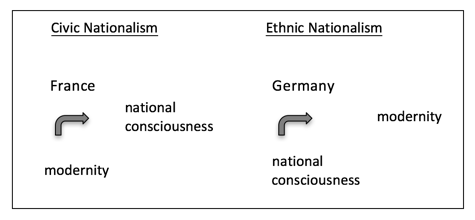Recall that a nation is a group of people who see themselves as united by various shared cultural features, including myths, religious beliefs, language, political ideologies, etc. Some scholars see nations as having deep roots extending back to ancient times. Smith (1986), for instance, claims that most nations are rooted in ethnic communities and that there is a sense in which nations have existed in various forms throughout recorded history.
On the other hand, Gellner (1983) and Anderson (1991) argue that nations merely imagine themselves as old, when in fact they are really recent historical developments, having only emerged in 19th century Europe with the rise of sophisticated high cultures and literate populations. Gellner and Anderson are counted among a group of scholars often referred to as modernists who argue that while there may have been elites in pre-modern societies with visions of nationhood, national consciousness is a mass phenomenon. According to this view, nations, as we understand them today, only came into being when societies developed ways of conveying a feeling of national unity to the masses. At first this occurred by means such as print and the spread of universal schooling and later by means of radio, film and television. What Gellner suggests, in fact, is that nations are a product of nationalism, which is not merely “the awakening of nations to self-consciousness,” as nationalists often proclaim, but instead “invents nations where they do not exist” (cited in Erikson, 2002: 96).

Two different historical processes of nationalism
It is perhaps also useful to point out that not all nations came to be nations in the same way, nor are all nations constituted in exactly the same way. Looking at nations in historical perspective, for instance, a distinction is often made between ethnic nations and civic nations. The difference turns on the question of whether the members of a population developed a feeling of national identity before or after the emergence of a modern state. As an illustration, historians often point to Britain and France as the first European nation-states to emerge through a process often described as civic nationalism. In other words, in Britain and France, the rational, civic, and political units of modernity came first, and the development of a national consciousness came later. On the other hand, Germany and Russia followed a path of ethnic nationalism in which the emergence of a national consciousness came first, followed by the development of a fully modern state (Nikolas, 1999).
Where does the United States fit into this scheme? Opinions vary. As Erikson (2002: 138) has pointed out, the U.S. differs in important ways from Europe. For one thing, it has no myths pointing to some supposed ancient origins. In fact, it was founded barely before the beginning of the modern era. This is not to say, however, that the U.S. lacks a national myth; only that it is not a myth lost in the mists of memory.
The American myth is instead a historical narrative stretching back only about 400 years when English settlers began arriving on the continent. The most important chapter perhaps (from the perspective of American national identity) revolves around the difficult and contentious negotiation of a set of founding ideals and principles, articulated in two rather brief documents: The Declaration of Independence and the Constitution. Thereafter, the myth continues with an account of the rapid population of the continent by successive waves of immigration from four other continents, Europe, Africa, Asia, and South America. However, in our telling of the national myth, we often omit the shameful history of injustice dealt to the indigenous First Nations (as they are called in Canada) or make of these details only footnotes. On the other hand, we usually do confront the history of slavery that nearly tore the nation apart in a civil war. We usually also recount the story of the more than 100-year struggle of African Americans to secure the full rights of citizenship, with its major 20th century victories, as these reinforce a narrative of American striving to live up to its ideals.
Today the United States is often described as multiethnic in the sense that many of its people can trace their ancestry to one or more geographic regions around the world. Indeed, while most Americans speak English, at least 350 different languages are spoken in U.S. homes, including languages from every (inhabited) continent, as well as 150 Native American languages (U. S. Bureau, 2015).
But is the U.S. an ethnic nation or a civic nation? Or to put it in historical terms, is the U.S. a product of ethnic nationalism or civic nationalism? Social scientists have often regarded the U.S. as a civic nation but not in the same way as Britain or France. American national identity is presumably based on shared cultural features rather than on shared ethnic heritage. However, American identity is complicated, and current public discourse suggests a sharp divide among American people.
One sees among many American conservatives, for instance, a tendency to stress the nation’s Colonial Era origins (1629-1763) with its Protestant (Christian) roots and its Revolutionary Era (1764-1800), featuring the Founding Fathers, who were mostly, white (male) and English. Theiss-Morse (2009: 15-16) sees this as at the root of an ethnocultural view of American identity. While many Americans may see this as only part of the story, there are some who see it as the most important part. Some Americans have embraced this particular narrative at various points throughout American history to promote nativist rhetoric and restrictive immigration policies. White supremacists often seize upon it in their efforts to marginalize, not only immigrants, but anyone not perceived to be ethnically “white,” Christian, and of European ancestry.
The liberal left, on the other hand, is more inclined to emphasize a view, which Theiss-Morse has called “American identity as a set of principles” (p. 18-20). Liberals tend to acknowledge the revolutionary achievements of the Founding Fathers in establishing the noble ideals and liberal political principles of liberty, equality, democracy, and constitutionalism. However, they do not hesitate to recognize that the Founding Fathers were flawed men, some of whom even defended the institution of slavery, while others continued to own slaves even after they saw that it contradicted the founding ideals. Moreover, liberals give equal weight to the story of American immigration, recognizing that the nation’s founding principles made room for newcomers who could come from anywhere and become American simply by embracing those principles. Identity as a set of principles seems more closely aligned to a multicultural, rather than an ethnocultural view of the nation.
While the above contrast somewhat over simplifies the complexities of American national identity, it does illustrate the fact that the question of American identity is a highly contested one. Kaufmann (2000) has claimed that the view of the U.S. as a civic nation is supported only if we restrict our attention to developments that have occurred since the 1960’s. According to Kaufmann, for almost its entire history, the political and cultural elite defined the U.S. in ethnic terms as white, Anglo-Saxon, and Protestant. During periods of high immigration, this elite expended great effort to assimilate immigrants to their own ethnic ideal, and when the growth of immigrant populations posed a challenge, defensive responses arose, including restrictions to immigration. In fact, from 1920-1960, this defensive response was institutionalized. After this long period in which national quotas kept a tight lid on immigration, the U.S. only became more open to immigration again in 1965 with the passage of the Immigration and Nationality Act.
The tendency, then, to see the U.S. as a civic nation of immigrants is a recent historical development. Nor is the U.S. exceptional in this respect. Rather, the U.S. is merely part of a broader trend among “Western” nations to redefine themselves in civic terms. In fact, Kaufmann (2000: 31) cites research showing that contrary to popular perceptions of the U.S. as a land of immigration, “Western Europe … has had a higher immigrant population than the United States since the 1970’s and by 1990 had proportionately two to three times the number of foreign-born” as the United States.
Whether the post-1960’s immigration trends will continue is currently in doubt across much of Western Europe and the United States as evidenced by such events as Great Britain’s decision in 2016 to withdraw from the European Union, the rise of far-right challenges to liberal European democracies, not to mention the 2016 U.S. election, which has brought in a president that apparently seeks to recreate immigration policies reminiscent of the exclusionary pre-1965 era.



